Democracy Actually Is Good at Governing Infrastructure, and Infrastructure Is Exactly What Democracy Should Govern
Matt Prewitt
September 7, 2021
In this essay I will link together several arguments that point toward a case for expanding – and doubling down on – multi-level democracy as an approach to managing infrastructure.
Flourishing societies have always depended integrally on infrastructure. Today this is truer than ever. But we’ve lost the plot regarding what infrastructure is. Therefore we’re putting infrastructure under the misrule of a set of institutions called “capitalism”, which were never meant to steward infrastructure wisely, and which in fact systematically mismanage it. For different reasons, technocratic state apparatuses are also absolutely terrible at managing infrastructure. So revitalized and expanded democracy is our only serious option.
To make democracy work better, we need to make democracy better. We need to make it something that we engage with more intimately, more locally, and more often – something that penetrates our lives more deeply than once-every-few-years ballots, and that governs more than just the occupants of a few sclerotic state offices. The challenges are real as rain, but there are also reasons to be very optimistic about this.
The argument proceeds like this.
First: infrastructure is best interpreted not as roads or power lines or anything else in particular, but as scarce resources upon which self-reinforcing processes depend.
Second: whoever owns (or has absolute authority over) infrastructure has immense power, because exponentially-evolving processes depend on it.
Third: capitalists should never own infrastructure. Capitalism isn’t built for that. The justifications of profit and private ownership end wherever infrastructure begins.
Fourth: technocratic management of infrastructure fails too, because the responsible stewardship of infrastructure depends on answering hypercomplex questions, the answers to which depend on information locked away in the minds of the people likely to be impacted by infrastructure.
Fifth: improved and expanded democratic practices, at multiple levels of society, are the way to elicit that information.
Finally we could do worse than to understand the wise stewardship of infrastructure, broadly construed, as the essential task of democracy.
Now I’ll try to flesh it out.
Abundance that Depends on Limited Resources
Many patterns of human activity strengthen themselves, tending toward exponential growth, resulting in limitless proliferation of wealth, culture, and other goods. Consider cities.
People go to cities in search of beneficial interactions with other people: culture, trade, conversations, and love.
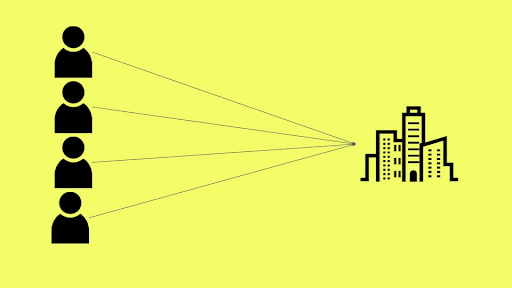
This connection-seeking pattern strengthens itself. The more people move to the city, the more culture, trade, conversations, and love the city contains, and the more strongly it therefore attracts others. People meet one another serendipitously in parks, metros, restaurants, and offices, striking up friendships, starting businesses and making art together, sharing ideas and inspiration. Diversity, wealth, and dynamism beget one another in virtuous circles. It’s like a big snowball getting bigger as it rolls downhill. Let’s call this an “abundant process”.
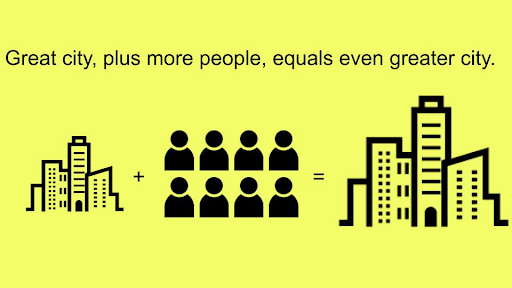
Not every pattern of activity is an abundant process. Some patterns are self-depleting. Consider roads.
Drivers use roads to go places fast. But each new driver on the road harms the usefulness of the road for everyone else by adding congestion and slowing traffic. The road is a scarce resource.
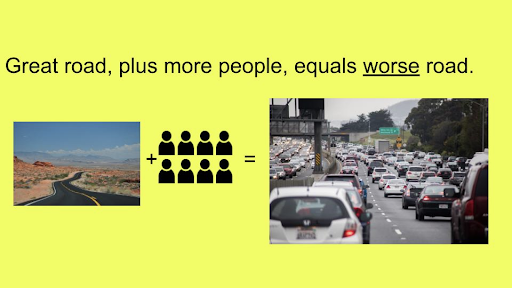
Eventually, the road grows so gridlocked that using it is barely faster than walking.
This is exactly opposite to how cities work. Adding more people makes cities more useful, but it makes roads less useful.
But Cities Need Roads
Notice, however, that abundant processes like cities depend intricately on finite, scarce resources like roads.
Without roads, people wouldn’t be able to live in big urban areas receiving shipments of distantly-produced essentials like food and medical supplies. The abundant magic of cities could never occur.
This is true of all abundant processes. Universities get better the more great scholars they attract – that’s an abundant process. But they can’t grow without adding new, all-too-finite buildings and equipment, or else scientists will start fighting over microscopes. Natural ecosystems, too, are abundant processes: the trees, bees, and other species support each other in virtuous circles. But whole ecosystems still depend on scarce resources like water. When a necessary resource runs low, it curtails the whole system’s exponential development.
Resource bottlenecks can slow or stop abundant processes.
Scarce Resources Are Infrastructure
It’s useful to see the similarity between human-made scarce resources like roads, and natural scarce resources like water. Everything we conventionally call infrastructure – roads, electrical grids, broadband, medical services, police protection, and so on – is basically an attempt to mitigate some kind of resource scarcity, in order to keep abundant processes rolling. Like natural ecosystems, human civilization is an abundant process that slows or stops when it reaches bottlenecks. Scarce resources are infrastructure, and vice versa.
Human systems depend on many of the same scarce resources as natural ones, such as water. Without water, cities don’t grow any more than oases do. Infrastructure like protected watersheds, reservoirs, and water mains help cities deal with that.
We also use ingenuity and technology to address more modern bottlenecks. For example, sewage accumulation limits residential density by spreading disease, so we have sewers. And the difficulty of communicating across distance slows collaboration and exchange, so we have telecom networks. Macro-scale bottlenecks sometimes form for which we do not yet have any effective infrastructure at all, such as the destruction of the atmosphere with CO2 emissions, and the acceleration of polarization on social media. But that’s for another essay. For now, I want to tell a clear story about the relationship between infrastructure and power.
Infrastructure Is Power
Anyone who controls infrastructure wields total power over the complex abundant processes thriving atop it. And whenever this power is wielded for self interest (instead of for the interests of the whole ecosystem), it curtails that thriving.
This is fairly obvious in the case of vital natural resources. Suppose you are the private owner of an aquifer feeding an oasis. You can then demand “rent” from the birds and palm trees. In fact, you can push those unfortunate creatures to within an inch of their lives. For if you shut off the water, their world ends.
The same goes for human-made infrastructure. If you – a private citizen, or a company, or a government – control the roads of a city, you can charge tolls upon them. And you have total bargaining power. For without the roads, the whole complexity of the city will be erased. Power over infrastructure is power to hold vast, thriving systems hostage.
Owning Infrastructure For Profit Is Bad
Understanding the power of infrastructure is the key to seeing the limits of capitalism, and also grasping the direction in which democracy must grow and evolve. Here’s why.
While the profit motive drives social efficiency in certain contexts, the exercise of authority over infrastructure is never one of those contexts. For whenever an owner of infrastructure takes a profit, they destroy value for society that exceeds the amount of the profit they take. The profit imperative makes them systematically bad stewards.
Before I explain this in more detail, simply observe that it conforms to conventional wisdom and common sense. It is the reason that utility companies are regulated, and the reason the state owns roads.
Here’s a quick explanation of the too-often-overlooked economic logic.
When Is Profit Socially Efficient?
The canonical justification of profit goes as follows. Entrepreneurs are operating in a competitive environment, and managing resource-constrained operations, such as factories where only so many laborers can work, and apartments where only so many people can live. Therefore, the value they generate diminishes with scale, like so:
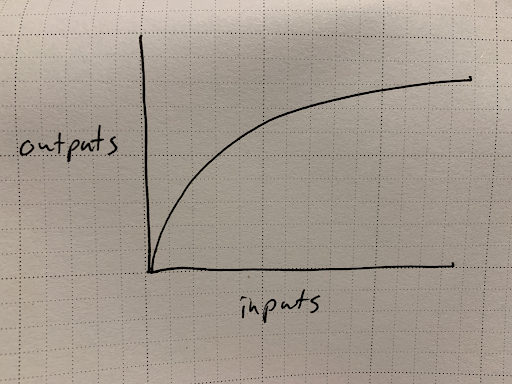
These resource constraints explain why capitalists can pay suppliers and workers their true marginal value – that is, a fair wage rate – while still making a profit. For this “diminishing marginal returns” structure of productivity implies that the marginal value of any input (such as labor) will be less than the average value of that input. So the difference between the marginal and average productivity may then be taken as profit.
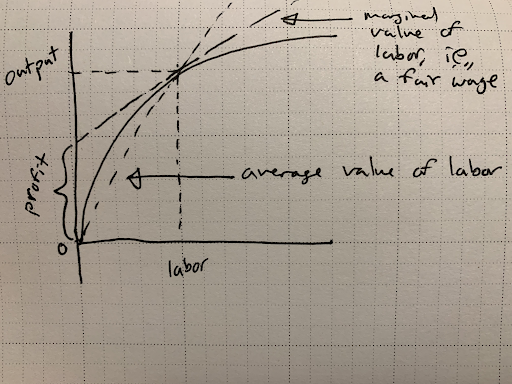
Let me repeat this important point: The social justification of profit depends on the assumption that the profitable activity has diminishing marginal returns – in other words, that it is a self-depleting, resource-constrained activity. This is a little bit subtle. I am including a footnote illustrating it further.[1]
And here’s the thing: this assumption is not always true!
When Is Profit Not Socially Efficient?
The logic that justifies profit is completely flipped with infrastructure. Because infrastructure doesn’t feed into self-depleting processes, but rather self-reinforcing, abundant ones: the serendipitous connections in a city, and the complex mutualism of an ecosystem. The value produced by such abundant processes scales instead like this:
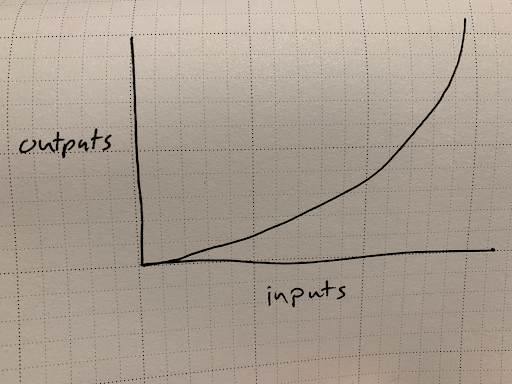
When value scales like that (i.e., exponentially), taking any kind of profit hurts society. For such extractions of value reduce output, effectively depriving society of the most vertical, “hockey stick” parts of the exponential, abundant processes.
Moreover, the payment of a fair wage – that is, payment equal to the marginal value added by each contributor to the process – becomes impossible, because the marginal value added by each contributor exceeds the average value added by all of them. If an owner of infrastructure tried to pay everyone for their marginal contribution of value to the system, it would bleed money and bankrupt itself.
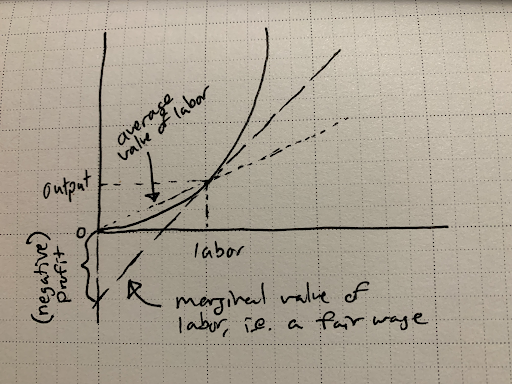
This is why the governors of infrastructure, for reasons of social efficiency, should never be profit-seeking enterprises.
Why Technocrats Also Fail
So if we don’t want capitalists running our infrastructure, how about decisive, expert, public-oriented state actors? It turns out they have problems too. Let’s see why.
In order to be efficient, stewards of infrastructure need to be accountable to all the parties affected by the complex processes that depend on the infrastructure – that is, the actual societies in which these abundant processes unfold. This means that three groups of people should be heavily-overlapping, indeed almost coincident:
a) the participants in abundant processes (i.e., the people living in the societies where they are happening);
b) the stewards of infrastructure (i.e., authorities); and
c) the exercisers of democratic power (i.e., voters).
Maximizing the flow of information and accountability between these groups is the only serious way of ensuring that infrastructure stewards don’t destroy value by either incompetence or rent-seeking.
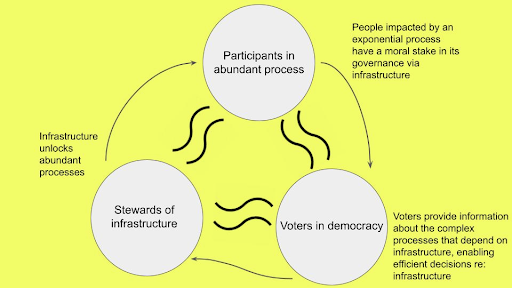
Here’s another way of looking at this: Capitalism fails at infrastructure stewardship because owners of infrastructure are systematically misaligned with the participants in abundant processes that depend on the infrastructure.
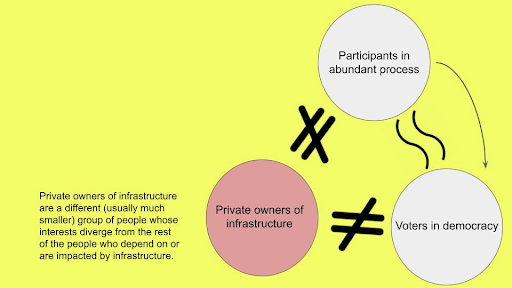
And, technocratic stewards have exactly the same problem.
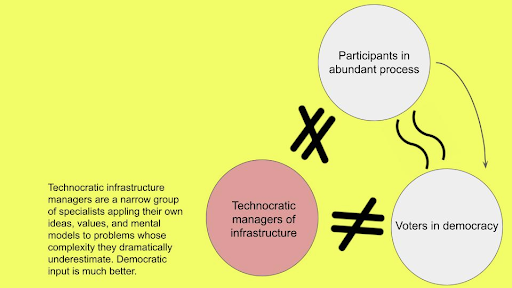
There is a real difference, though, between government decision-makers who listen thoughtfully and rigorously to democratic input, and technocrats who don’t. Both can be well-intentioned. But technocrats who dismiss democratic input deprive themselves of necessary information. They’re trying to govern society without the benefit of context. It’s like flying blind. Proceeding this way, they can appear to get a lot done, quickly. But it’s a short-run illusion: In the longer run, they crash. Or worse: they fly somewhere they didn’t mean to go.
Technocrats inevitably overlook important interests. They have mental maps that don’t match the territory. They understand the communities they come from (usually privileged ones) better than other communities. Their unilateral stewardship of infrastructure thus introduces distortions that reflect their personal, biographical, and psychological limitations.
Obvious failure modes include investing in infrastructure nobody wants, like “bridges to nowhere”. But failure can also take subtler forms, like building highways in places that serve the wealthy or connected, while immiserating the poor or marginalized. Think, for example, of Robert Moses, New York’s famously imperious 20th-century urban planner. Exercising unilateral power, he got bridges and highways built. It wasn’t all bad. But he destroyed and marginalized Black and poor communities to do it. Those harms plague society in less visible ways, decades later.
Thus, technocratic governance can take societies full steam ahead toward an unattractive, dysfunctional future. Years of apparent progress are reevaluated in the fullness of time as decades of folly.
The subtler issues are hard for technocrats to foresee in their planning spreadsheets. But they are at the very heart of normative political conversations. Thus, broad-based participation in decision-making is our best way of understanding them.
Smart 21st-century governments with a democratic mindset try to get this right. They try to achieve coincidence between the governor and the governed, and they generally do a much better job representing the public interest than private parties would. But they often fail nonetheless. Sometimes they lack the tools or the mandate to incorporate rich and legitimate democratic feedback into their decisions. Sometimes they use problematic institutions like town hall or public planning meetings. They need to do better, and many are working on it.[2]
And Why Is Democracy Good At Infrastructure Management?
Infrastructure doesn’t fully determine the kind of activities that thrive on top of it. A phone line doesn’t dictate what people are going to talk about. The Brooklyn Bridge works just as well no matter why you want to cross the East River.
For this reason, questions like where infrastructure is needed, what it’s needed for, and how it ought to be managed, are too complex for experts alone to answer. Every theory about the consequences of a particular infrastructure investment is only that, a theory. And when theories deal with very complex systems, their predictive power fades. Having lots of data becomes more important.
The thing is, everybody impacted by infrastructure holds in their mind precious data about what that infrastructure is good or bad for, and how it therefore ought to be stewarded. In this sense, impacted parties are always qualified to contribute critical information to meaningful decisions about infrastructure. These are the people who will (or won’t) build social structures atop it, whose lives will be altered by it. They have to have a say.
Moreover, giving people genuine democratic authority is the only way to incorporate their insights into decisions. You cannot just surveill people and interpret that as a signal about what they need, because people’s actions don’t express their ideals.[3] What they do isn’t necessarily what they wish to do, or hope to do, or would do if they were differently resource-constrained. Passive, surveillance-based citizen feedback is not democratic participation at all: it’s just a weird, counterproductive reification of society’s present patterns.
Yes, democratic infrastructure governance is egalitarian. But it need not be motivated by egalitarianism, because wise and efficient long-term governance simply can’t happen without egalitarian and democratic decision-making. This is turtles all the way down.
In a sense, infrastructure governance is exactly what legitimate democratic power should do – no more and no less. Most literature on government legitimacy concerns the legitimacy of coercion. But that whole literature fits cleanly with this framework. After all, private ownership of infrastructure depends upon government coercion (e.g., police protecting property). And government coercion depends on its control of scarce resources (e.g., the biggest guns, fastest helicopters, and deepest surveillance). Thus, scarce resource control (which is to say, infrastructure governance) is simply the inseparable flipside of coercion’s coin.
How We Can Get Better At This
Glen Weyl has written about mismatches between “actual polities” and “natural polities”. This gets at the same idea. Infrastructure always has a “natural” constituency, a set of people whose interests it de facto affects. When the people who “actually” govern the infrastructure do not match that group, the stage is set for exploitation and waste on a systemic level. Actual polities, when misaligned with natural polities, govern infrastructure without full information or attention regarding the complex systems it feeds or strangles.
Perhaps the hardest problem for democracy, then, is determining who belongs in that “natural polity” – that set of people that should jointly make a particular infrastructural decision. It isn’t known in advance.
But getting better at finding those “natural polity” sets, and inviting them into democratic processes, might be the key to nimbler and healthier societies. We are taking steps in that direction with the experimental processes in RadicalxChange Voice, where groups of people can invite participants into group deliberative processes and distribute voice credits amongst themselves (matched by quadratic funding). Processes of “finding the right polity” for public decisions also informed the thinking behind the Data Freedom Act.
Infrastructure is all around us. We interact with it every day, in countless ways. Democracy should be no different. We hope you’ll help us work toward making that happen.
A big thanks to Glen Weyl for major contributions to this piece. Many thanks also to Paula Berman, Albert Wenger, Alex Randaccio, and Angela Corpus.
Notes
Imagine an apple orchard full of 100 workers harvesting apples. The hundredth harvester in the orchard picks apples worth about $15 each hour; this is the “marginal value of labor”. Consequently, all hundred employees in the factory are paid $15 per hour: after all, any one of them could be fired at any time; and $15 per hour is all the owner would lose. However, the first few employees entering the orchard can harvest apples at a much faster clip than that. This might seem mysterious but it isn’t. It’s simply that, in a nearly-empty orchard, they can run around picking the low-hanging fruits. The last employees added to an orchard full of workers, on the other hand, have to go after the hard-to-reach apples near the tops of the trees. Because the first few harvesters can produce faster than the last few harvesters, all hundred employees taken together can produce at a rate that exceeds $15/hour times 100: average productivity exceeds the marginal productivity. The owner pays out $1500 per hour, an honest recognition of each worker’s marginal contribution to the enterprise, but the workers are producing more than that in aggregate. If they produce $2000 per hour, the owner keeps $500 per hour as profit. Competitors, seeing that sweet, juicy profit, will enter the industry. As the apple orchard game grows more competitive, apple prices will go down or wages will go up; and profit will become harder to come by. Thus entrepreneurs pursuing profit make workers and consumers better off. ↩︎
Important work is happening along these lines, partly inspired by Taiwan’s successes with digital democracy. RadicalxChange’s Voice project is a key example. ↩︎
For example, you can’t just look at traffic patterns to determine where people want to go. People might want to go to different places if new roads were built, or old ones were torn up. ↩︎